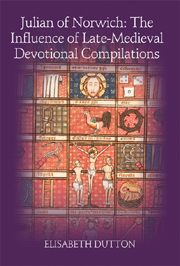1 - Ordinatio and compilatio and the Revelation's Apparatus
Published online by Cambridge University Press: 12 September 2012
Summary
The short text of Julian of Norwich's Revelation of Love is a brief, vivid description of the visionary experience of a woman on the point of death. It begins with an account of the circumstances in which revelation is received, relates the bulk of the visionary material, describes Julian coming round to have her visions affirmed then falling asleep and being visited by devils, and concludes with her waking vision of christ in her soul. Within this simple narrative there is an awareness of separate revelations constituting the visionary material, and an organization of the content of separate revelations: for example Julian comments that ‘In this firste shewinge of oure lorde I sawe sex thinges … The furste is the takens of his blisfulle passion … The seconde is … The thirde is …’ etc. (71/4–73/17). Julian's reflection on her visions is signalled here. There is also careful categorization of modes of revelation, and cross-reference: ‘Alle the blissede techinge of oure lorde god was shewed to me be thre parties as I hafe saide before: that es to saye, be bodely sight, and be worde formed in min undyrstandinge, and by gastelye sight’ (115/49–51). The short text is a carefully constructed visionary account.
In the long text the account of visionary experience is interlaced with lengthier passages of devotional and theological commentary on the revelation. Organization of material via categorization and cross-reference continues, but is facilitated by a more explicit structure: it is specified that the visionary material described contains sixteen constituent revelations, and the Revelation is divided into chapters. A table of contents is provided in which the sixteen revelations are detailed.
- Type
- Chapter
- Information
- Julian of NorwichThe Influence of Late-Medieval Devotional Compilations, pp. 25 - 51Publisher: Boydell & BrewerPrint publication year: 2008



